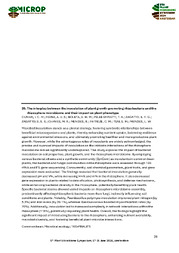The interplay between the inoculation of plant growth-promoting rhizobacteria and the rhizosphere microbiome and their impact on plant phenotype.
The interplay between the inoculation of plant growth-promoting rhizobacteria and the rhizosphere microbiome and their impact on plant phenotype.
Autoria: CUNHA, I. C. M.; REINA, A. V. S.; BOLETA, E. H. M.; PELLEGRINETTI, T. A.; ZAGATTO, L. F. G.; ZAGATTO, S. S. S.; CHAVES, M. R.; MENDES, R.; PATREZE, C. M.; TSAI, S. M.; MENDES, L. W.
Resumo: Microbial inoculation stands as a pivotal strategy, fostering symbiotic relationships between beneficial microorganisms and plants,thereby enhancing nutrient uptake, bolstering resilience against environmental stressors, and ultimately promoting healthier and more productiveplant growth. However, while the advantageous roles of inoculants are widely acknowledged, the precise and nuanced impacts of inoculation onthe intricate interactions of the rhizosphere microbiome remain significantly underexplored. This study explores the impact of bacterialinoculation on soil properties, plant growth, and the rhizosphere microbiome. By employing various bacterial strains and a synthetic community(SynCom) as inoculants in common bean plants, the bacterial and fungal communities in the rhizosphere were assessed through 16S rRNA andITS gene sequencing. Concurrently, soil chemical parameters, plant traits, and gene expression were evaluated. The findings revealed thatbacterial inoculation generally decreased pH and V%, while increasing H+Al and m% in the rhizosphere. It also decreased gene expression inplants related to detoxification, photosynthesis, and defense mechanisms, while enhancing bacterial diversity in the rhizosphere, potentiallybenefiting plant health. Specific bacterial strains showed varied impacts on rhizosphere microbiome assembly, predominantly affectingrhizospheric bacteria more than fungi, indirectly influencing soil conditions and plants. Notably, Paenibacillus polymyxa inoculation improvedplant nitrogen (by 5.2%) and iron levels (by 28.1%), whereas Bacillus cereus boosted mycorrhization rates (by 70%). Additionally, inoculationled to increased complexity in network interactions within the rhizosphere (~15%), potentially impacting plant health. Overall, the findingshighlight the significant impact of introducing bacteria to the rhizosphere, enhancing nutrient availability, microbial diversity, and fosteringbeneficial plant-microbe interactions.
Ano de publicação: 2024
Tipo de publicação: Resumo em anais e proceedings
Unidade: Embrapa Meio Ambiente
Palavras-chave: 16S rRNA, Common bean, Feijão, ITS, microbial ecology
Observações
1 - Por padrão são exibidas publicações dos últimos 20 anos. Para encontrar publicações mais antigas, configure o filtro ano de publicação, colocando o ano a partir do qual você deseja encontrar publicações. O filtro está na coluna da esquerda na busca acima.
2 - Para ler algumas publicações da Embrapa (apenas as que estão em formato ePub), é necessário ter, no celular ou computador, um desses softwares gratuitos. Sistemas Android: Google Play Livros; IOS: iBooks; Windows e Linux: software Calibre.
Acesse outras publicações
Acesse a Base de Dados da Pesquisa Agropecuária (BDPA) para consultar o acervo completo das bibliotecas da Embrapa.

